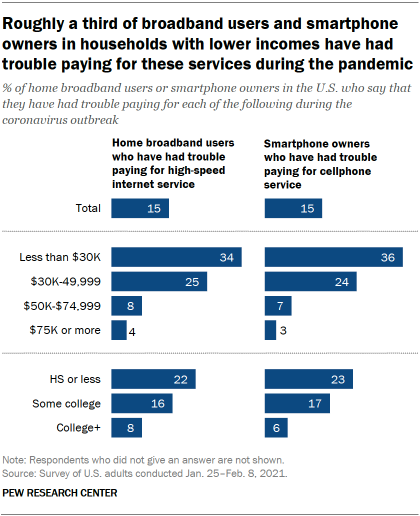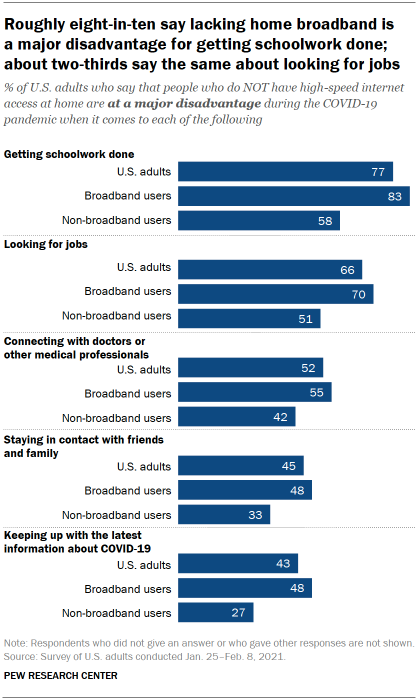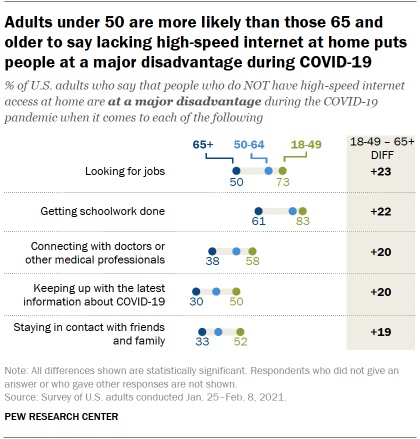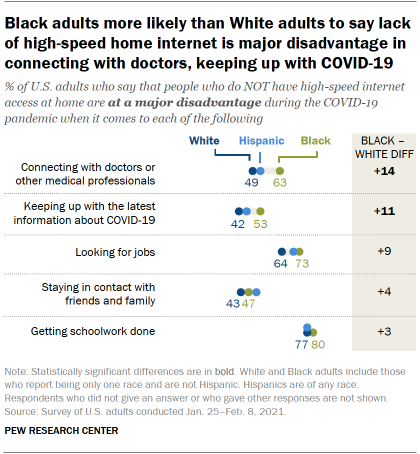Some 15% of home broadband users in the United States say they have had trouble paying for their high-speed internet service during the coronavirus outbreak. That includes 34% of those with household incomes of less than $30,000 a year, according to a Pew Research Center survey of U.S. adults conducted Jan. 25-Feb. 8, 2021.
While the pandemic took a notable toll on the finances of Americans with lower incomes, some broadband users in households earning more have also struggled to pay for this service. A quarter of home broadband users with annual household incomes ranging from $30,000 to just under $50,000 say they have had trouble doing so in the pandemic, as have roughly one-in-ten (8%) with household incomes ranging from $50,000 to $74,999.
There are also differences by Americans’ educational attainment. Some 22% of broadband users who have a high school diploma or less have had trouble paying for this service. A similar share (16%) of those who have some college education, but do not have a degree, say the same. By comparison, a smaller share of college graduates (8%) have had trouble paying for high-speed internet service.
To better understand the role of the internet in Americans’ lives during the coronavirus pandemic, Pew Research Center surveyed 1,502 U.S. adults from Jan. 25 to Feb. 8, 2021, by cellphone and landline phone. The survey was conducted by interviewers under the direction of Abt Associates and is weighted to be representative of the U.S. adult population by gender, race, ethnicity, education and other categories. Here are the questions used for this report, along with responses, and its methodology.
Many Americans also report difficulty paying for other kinds of connectivity – like cellphone service and cable or satellite television – during COVID-19, with similar differences by income and education.
Some 15% of smartphone owners say they have had trouble paying for their cellphone service during the pandemic. That includes 36% in households earning less than $30,000 annually and 24% in households earning $30,000 to $49,999.
These percentages are nearly identical when it comes to cable or satellite television services. Overall, 16% of cable or satellite TV subscribers have had difficulty paying for these services during the outbreak, as have 37% of those in households earning less than $30,000 a year and 24% in households earning between $30,000 and $49,999 a year.
Among those who are “smartphone dependent” for their internet connectivity – that is, people who own a smartphone, but do not subscribe to broadband at home – 27% say they have had trouble paying for their cellphone service amid COVID-19. Previous Pew Research Center studies have shown that Americans with lower incomes and less formal education are especially likely to be smartphone dependent in this way.
These new findings come amid efforts by the federal government to make emergency broadband funds available for Americans with lower incomes and establish programs to help close the “homework gap.” Overall, about a quarter of Americans without a broadband connection at home (23%) cite financial constraints as one of the most important reasons why they forgo these services, according to separate survey findings released today by the Center.
Americans see a variety of disadvantages for those who lack home broadband access
The internet has played an important, even essential role in many Americans’ lives during the pandemic. But there continue to be digital divides, including those related to affordability. The Center’s latest survey on the topic shows that many Americans think not having home broadband puts people at a disadvantage during the pandemic. But there are some differences in the specific ways they think this disadvantage plays out.
Overall, majorities of U.S. adults say people without high-speed internet at home are at a major disadvantage during the pandemic when it comes to getting schoolwork done (77%) and looking for jobs (66%). Smaller shares say those who lack access are at a major disadvantage when it comes to connecting with doctors or other medical professionals (52%), staying in contact with friends and family (45%), and keeping up with the latest information about COVID-19 (43%).
There are striking differences in these views between broadband users and those who don’t have it. For instance, 83% of home broadband users say people who don’t have it are at a major disadvantage in getting schoolwork done during the pandemic, and 70% say the same about looking for jobs. Among those who don’t have broadband at home, smaller but still notable shares say lacking it is a major disadvantage when it comes to schoolwork (58%) or job searching (51%).
Home broadband users are also much more likely than non-users to see major disadvantages when it comes to keeping up with information about COVID-19 (21 percentage points), staying in contact with friends and family (15 points) and connecting with doctors or other medical professionals (13 points).
Americans’ views on these questions also vary by age and race and ethnicity.
Adults ages 18 to 49 are far more likely than those 65 and older to say that lacking high-speed internet access at home puts people at a major disadvantage during the pandemic in each of the five ways explored in the survey – with differences of roughly 20 percentage points or more between the two groups. For example, about three-quarters (73%) of adults ages 18 to 49 say lacking high-speed internet at home puts people at a major disadvantage in looking for jobs, compared with half of those 65 and older. And 83% of adults ages 18 to 49 say this about getting schoolwork done, versus a smaller share of Americans 65 and older (61%).
On some of these questions, but not all, there are also differences by race and ethnicity. Black adults, for example, are more likely than White adults to say not having home broadband access puts people at a major disadvantage in connecting with doctors or other medical professionals (63% vs. 49%) and keeping up with information about the pandemic (53% vs. 42%). The shares of Hispanic adults who see these as major disadvantages do not statistically differ from those of other racial and ethnic groups.
Separate survey findings recently released by the Center found that Hispanic (65%) and Black adults (71%) are less likely than White adults (80%) to have broadband at home. (In that survey, as well as the new analysis, there were not enough Asian American respondents in the sample to be broken out separately. As always, their responses are incorporated into the general population figures reported throughout this analysis.)
Note: Here are the questions used for this report, along with responses, and its methodology.




